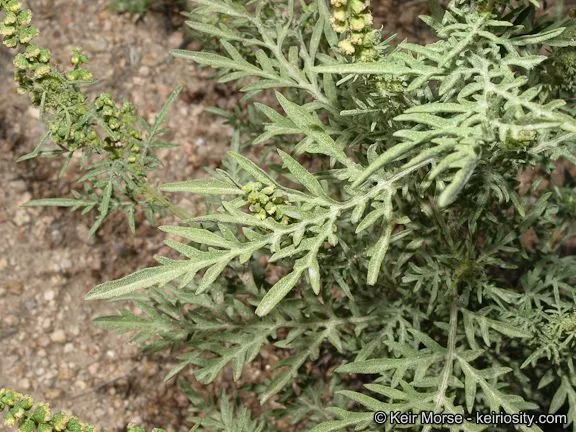
Author: DC.
Bibliography: Prodr. 5: 526 (1836)
Year: 1836
Status: accepted
Rank: species
Genus: Ambrosia
Vegetable: Unknown
Observations: U.S.A. to Mexico
Bur ragweed, scientifically known as Ambrosia confertiflora, belongs to the Asteraceae family, a diverse group renowned for its flowering species. This hardy perennial is indigenous to regions extending from the United States down to Mexico, thriving in varied terrains.
First introduced in the 1836 publication “Prodr. 5: 526” by the accomplished botanist DC, Ambrosia confertiflora stands out due to its adaptive nature and distinct physical features. Typically, bur ragweed exhibits a robust growth form, with a series of green, often hairy stems that bear a rough texture courtesy of small, bur-like projections. These projections are not merely for show but play a role in the plant’s reproduction and spread, facilitating its pervasion across landscapes through seed adherence to passing animals or human clothing.
The foliage of the bur ragweed is notable for its deeply lobed, pale green leaves, which, when crushed, release a scent that is typical of many species within the Asteraceae family. During its blooming period, Ambrosia confertiflora produces small, inconspicuous flowers clustered tightly together. These clusters, or inflorescences, contribute to the plant’s scientific epithet, “confertiflora,” which implies closely packed flowers.
In its natural habitat, the bur ragweed plays an essential role in the ecosystem. It provides cover and sometimes forage for local wildlife, while also competing aggressively with other plant species for resources. Its resilience and competitive nature, however, can sometimes pose challenges, especially in agricultural settings where it may become an unwelcome invader.
Understanding the ecological impact and management of bur ragweed is crucial, particularly for farmers and land managers in its native range throughout the United States and Mexico. As with many members of the Asteraceae family, Ambrosia confertiflora showcases the resilience, adaptability, and botanical intricacies that exemplify this large and complex family of flowering plants.
Heb: ambrosia mecuneset
Eng: bur ragweed, ragweed, weakleaf bur ragweed, weakleaf burr ragweed, burr ragweed, slimleaf bursage
En: Bur ragweed, Weakleaf bur ragweed, Slimleaf bursage, Weakleaf burr ragweed, Ragweed, Burr ragweed
He: Ambrosia mecuneset, אמברוסיה מכונסת
Taken Jul 18, 2021 by John Short (cc-by-sa)
Taken Jul 21, 2019 by CJL (cc-by-sa)
Taken Sep 29, 2021 by Shaeanna Downey (cc-by-sa)
Taken Oct 18, 2014 by EOL − Richard Spellenberg (cc-by-nc-sa)
Taken Oct 19, 2014 by EOL − Richard Spellenberg (cc-by-nc-sa)
Taken Nov 9, 2012 by EOL − Keir Morse (cc-by-nc-sa)
Taken Nov 9, 2012 by EOL − Keir Morse (cc-by-nc-sa)
Taken Nov 9, 2012 by EOL − Keir Morse (cc-by-nc-sa)
Taken Nov 9, 2012 by EOL − Keir Morse (cc-by-nc-sa)
Taken Jun 5, 2015 by EOL − snakeinmypocket (cc-by-nc)
© copyright of the Board of Trustees of the Royal Botanic Gardens, Kew.
Family: Myrtaceae Author: (F.Muell.) K.D.Hill & L.A.S.Johnson Bibliography: Telopea 6: 402 (1995) Year: 1995 Status:…
Family: Rubiaceae Author: Pierre ex A.Froehner Bibliography: Notizbl. Bot. Gart. Berlin-Dahlem 1: 237 (1897) Year:…
Family: Sapindaceae Author: Koidz. Bibliography: J. Coll. Sci. Imp. Univ. Tokyo 32(1): 38 (1911) Year:…
Family: Asteraceae Author: A.Gray Bibliography: Pacif. Railr. Rep.: 107 (1857) Year: 1857 Status: accepted Rank:…
Family: Fabaceae Author: Medik. Bibliography: Vorles. Churpfälz. Phys.-Ökon. Ges. 2: 398 (1787) Year: 1787 Status:…
Family: Aspleniaceae Author: (Cav.) Alston Bibliography: Bull. Misc. Inform. Kew 1932: 309 (1932) Year: 1932…